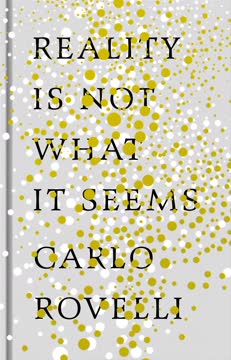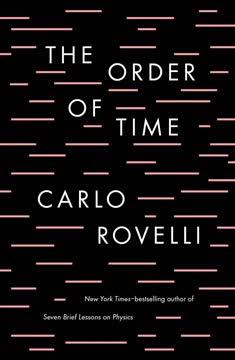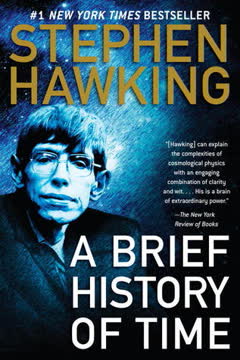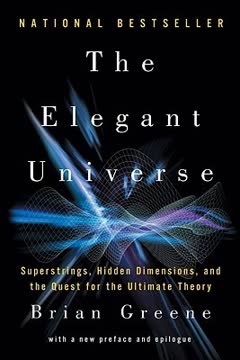Key Takeaways
1. Quantum Mechanics: A Revolution Shrouded in Mystery
However, the worldview demanded by quantum theory is not only stranger than we might suppose, it’s stranger than we can suppose.
Quantum theory's success. Quantum mechanics is the most successful theory in physics, underpinning much of modern technology. Yet, its implications challenge our deepest intuitions about reality. It suggests that observation plays a fundamental role in creating the physical world, a concept that has baffled physicists and philosophers alike.
Einstein's skepticism. Albert Einstein, despite his contributions to quantum theory, remained deeply skeptical of its implications. He famously questioned whether the moon only exists when someone is looking at it, highlighting the theory's apparent denial of an objective, observer-independent reality. This skepticism fueled decades of debate and research into the foundations of quantum mechanics.
The measurement problem. The core of the quantum enigma lies in the "measurement problem." Quantum theory describes objects as existing in a superposition of states until measured, at which point the superposition collapses into a single, definite state. This raises profound questions about the nature of observation, reality, and the role of consciousness in the physical world.
2. Classical Physics: A World of Determinism and Reality
Nature and Nature’s laws lay hid in night: / God said, Let Newton be! And all was light.
Newtonian worldview. Classical physics, epitomized by Newton's laws, presents a deterministic and objective view of the universe. In this worldview, objects have definite properties, and their behavior is governed by predictable laws. The future is determined by the present state of the universe.
Determinism and free will. The determinism of classical physics poses a challenge to the concept of free will. If the future is predetermined, then our choices are merely illusions, and we are not truly free agents. This conflict between determinism and free will has been a long-standing philosophical debate.
Limitations of classical physics. While classical physics provides an excellent approximation for many phenomena, it fails to accurately describe the behavior of atoms and other microscopic objects. This failure led to the development of quantum mechanics, which revolutionized our understanding of the physical world.
3. The Quantum Enigma: Observation Creates Reality
Quantum theory thus denies the existence of a physically real world independent of its observation.
The two-slit experiment. The two-slit experiment vividly demonstrates the quantum enigma. When particles are sent through two slits, they create an interference pattern, suggesting they behave as waves. However, when one attempts to observe which slit each particle passes through, the interference pattern disappears, and the particles behave as if they are compact objects.
The role of observation. This experiment suggests that the act of observation fundamentally alters the behavior of quantum objects. It challenges the classical notion of an objective reality that exists independently of our perception. The observer seems to play a crucial role in shaping the physical world.
Neg Ahne Poc parable. The story of the physicist's visit to Neg Ahne Poc illustrates the quantum enigma in a non-technical way. The shaman's ability to manipulate the couple's presence in different huts based on the visitor's questions mirrors the way quantum experiments seem to create reality through observation.
4. Copenhagen Interpretation: A Pragmatic Approach
[T]hat he may sometimes have missed the target in his speculations, as, for example, in his hypothesis of light quanta, cannot really be held too much against him. . . .
Bohr's perspective. The Copenhagen interpretation, developed by Niels Bohr and his colleagues, offers a pragmatic approach to the quantum enigma. It emphasizes the importance of experimental results and the limitations of our ability to describe the quantum world in classical terms.
Two realms. Copenhagen divides the world into two realms: the macroscopic, classical realm of our measuring instruments, and the microscopic, quantum realm of atoms and other small things. It argues that since we never deal directly with the quantum objects of the microscopic realm, we need not worry about their physical reality, or their lack of it.
"Shut up and calculate." The Copenhagen interpretation has been summarized as "shut up and calculate!" This reflects its focus on using quantum mechanics to make accurate predictions, rather than dwelling on its philosophical implications. It has been the dominant approach in physics for decades.
5. Bell's Theorem: Spooky Action at a Distance
I cannot seriously believe in [quantum theory] because . . . physics should represent a reality in time and space, free from spooky action at a distance.
Einstein's challenge. Einstein, Podolsky, and Rosen (EPR) challenged the completeness of quantum mechanics by proposing a thought experiment that highlighted the theory's non-locality. They argued that if quantum mechanics were complete, it would have to allow for "spooky action at a distance," where the measurement of one particle instantaneously affects the state of another, even if they are separated by vast distances.
Bell's inequality. John Bell transformed the EPR argument into an experimentally testable prediction. He derived an inequality that must hold if reality and locality are both true. Experiments have consistently violated Bell's inequality, demonstrating that our world cannot have both properties.
Entanglement. The violation of Bell's inequality implies that quantum entanglement is a real phenomenon. Entanglement is a connection between two or more particles that allows them to share the same fate, no matter how far apart they are. This has profound implications for our understanding of space, time, and causality.
6. Consciousness: The Ultimate Mystery
What is meant by consciousness we need not discuss; it is beyond all doubt.
The hard problem. David Chalmers identified the "hard problem" of consciousness as explaining how physical processes in the brain give rise to subjective experience. This problem goes beyond simply correlating brain activity with conscious states; it seeks to explain why and how consciousness arises in the first place.
Reductionism and consciousness. Some scientists believe that consciousness can be fully explained by reducing it to its underlying physical components. Others argue that consciousness is a fundamental property that cannot be reduced to simpler entities. This debate is central to the philosophy of mind.
The observer problem. The quantum enigma raises the possibility that consciousness plays a fundamental role in shaping the physical world. This has led some to speculate that consciousness is not merely a product of the brain, but a fundamental aspect of reality.
7. Quantum Cosmology: The Universe and the Observer
The universe begins to look more like a great thought than a great machine.
The Big Bang. Modern cosmology describes the universe as originating from a Big Bang, an event that occurred approximately 14 billion years ago. Quantum theory is essential for understanding the conditions in the early universe.
Dark energy and dark matter. Observations suggest that the universe is composed primarily of dark energy and dark matter, mysterious entities that we do not yet fully understand. These components challenge our current understanding of physics and cosmology.
The observer in cosmology. Some cosmologists have speculated that consciousness may play a role in the evolution of the universe. This idea is highly speculative, but it highlights the profound questions raised by quantum mechanics and cosmology.
8. Interpretations: Seeking Meaning Beyond the Equations
I have thought a hundred times as much about the quantum problem as I have about general relativity theory.
Copenhagen interpretation. The Copenhagen interpretation, while pragmatic, leaves many questions unanswered. It does not provide a clear explanation of what constitutes an observation or how the collapse of the wavefunction occurs.
Many-Worlds Interpretation. The Many-Worlds Interpretation suggests that every quantum measurement causes the universe to split into multiple parallel worlds, each representing a different possible outcome. This interpretation avoids the problem of wavefunction collapse but raises questions about the nature of reality and the existence of other worlds.
Bohmian Mechanics. Bohmian mechanics posits that particles have definite positions and are guided by a "quantum potential" that depends on the wavefunction. This interpretation restores determinism to quantum mechanics but introduces non-locality and a complex, interconnected universe.
Last updated:
Review Summary
Quantum Enigma explores quantum mechanics and consciousness, explaining complex concepts accessibly. Many readers found it thought-provoking and enlightening, praising its clear explanations of quantum phenomena and their implications. Some appreciated the historical context and philosophical discussions, while others felt it was repetitive or lacked depth in certain areas. The book's approach to consciousness and reality sparked both intrigue and skepticism among readers, with some finding it fascinating and others questioning its scientific rigor.
Similar Books









Download PDF
Download EPUB
.epub digital book format is ideal for reading ebooks on phones, tablets, and e-readers.




